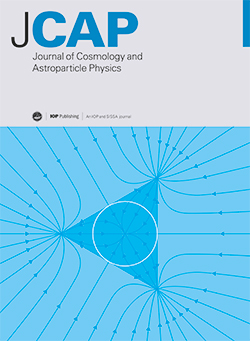Hybrid summary statistics: neural weak lensing inference beyond the power spectrum
IF 5.3
2区 物理与天体物理
Q1 ASTRONOMY & ASTROPHYSICS
Journal of Cosmology and Astroparticle Physics
Pub Date : 2025-01-21
DOI:10.1088/1475-7516/2025/01/095
引用次数: 0
Abstract
Cosmological inference relies on compressed forms of the raw data for analysis, with traditional methods exploiting physics knowledge to define summary statistics, such as power spectra, that are known to capture much of the information. An alternative approach is to ask a neural network to find a set of informative summary statistics from data, which can then be analysed either by likelihood- or simulation-based inference. This has the advantage that for non-Gaussian fields, they may capture more information than two-point statistics. However, a disadvantage is that the network almost certainly relearns that two-point statistics are informative. In this paper, we introduce a new hybrid method, which combines the best of both: we use our domain knowledge to define informative physics-based summary statistics, and explicitly ask the network to augment the set with extra statistics that capture information that is not already in the existing summaries. This yields a new, general loss formalism that reduces both the number of simulations and network size needed to extract useful non-Gaussian information from cosmological fields, and guarantees that the resulting summary statistics are at least as informative as the power spectrum. In combination, they can then act as powerful inputs to implicit inference of model parameters. We use a generalisation of Information Maximising Neural Networks (IMNNs) to obtain the extra summaries, and obtain parameter constraints from simulated tomographic weak gravitational lensing convergence maps. We study several dark matter simulation resolutions in low- and high-noise regimes. We show that i) the information-update formalism extracts at least 3× and up to 8× as much information as the angular power spectrum in all noise regimes, ii) the network summaries are highly complementary to existing 2-point summaries, and iii) our formalism allows for networks with extremely lightweight architectures to match much larger regression networks with far fewer simulations needed to obtain asymptotically optimal inference.混合汇总统计:超越功率谱的神经弱透镜推理
宇宙学推理依赖于原始数据的压缩形式进行分析,传统方法利用物理知识来定义汇总统计,例如功率谱,已知可以捕获大部分信息。另一种方法是让神经网络从数据中找到一组信息汇总统计,然后可以通过基于似然或模拟的推理来分析。这样做的好处是,对于非高斯场,它们可以捕获比两点统计更多的信息。然而,缺点是网络几乎肯定会重新学习两点统计信息。在本文中,我们引入了一种新的混合方法,它结合了两者的优点:我们使用我们的领域知识来定义基于信息物理的汇总统计,并明确地要求网络用额外的统计来增加集合,以捕获现有摘要中不存在的信息。这产生了一种新的、通用的损失形式,它减少了从宇宙学场中提取有用的非高斯信息所需的模拟次数和网络大小,并保证最终的汇总统计数据至少与功率谱一样具有信息量。结合起来,它们可以作为模型参数隐式推理的强大输入。我们使用信息最大化神经网络(IMNNs)的推广来获得额外的摘要,并从模拟层析弱引力透镜收敛映射中获得参数约束。我们研究了在低噪声和高噪声条件下的几种暗物质模拟分辨率。我们表明,i)信息更新形式主义在所有噪声条件下提取的信息至少是角功率谱的3倍到8倍,ii)网络摘要与现有的两点摘要高度互补,iii)我们的形式主义允许具有极轻架构的网络匹配更大的回归网络,而获得渐近最优推理所需的模拟要少得多。
本文章由计算机程序翻译,如有差异,请以英文原文为准。
求助全文
约1分钟内获得全文
求助全文
来源期刊

Journal of Cosmology and Astroparticle Physics
地学天文-天文与天体物理
CiteScore
10.20
自引率
23.40%
发文量
632
审稿时长
1 months
期刊介绍:
Journal of Cosmology and Astroparticle Physics (JCAP) encompasses theoretical, observational and experimental areas as well as computation and simulation. The journal covers the latest developments in the theory of all fundamental interactions and their cosmological implications (e.g. M-theory and cosmology, brane cosmology). JCAP''s coverage also includes topics such as formation, dynamics and clustering of galaxies, pre-galactic star formation, x-ray astronomy, radio astronomy, gravitational lensing, active galactic nuclei, intergalactic and interstellar matter.
 求助内容:
求助内容: 应助结果提醒方式:
应助结果提醒方式:


